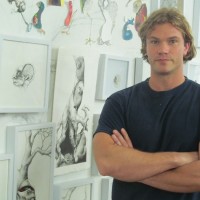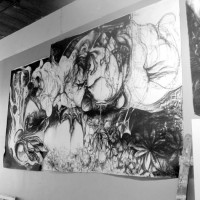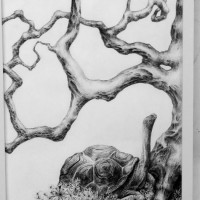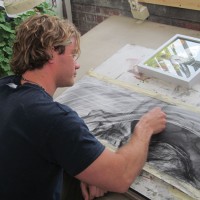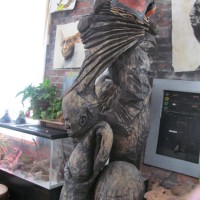Entertainment
Artist in Residence: John Selburg
"Will money pay for all the days you lived awake but half asleep?"
The words above, a takeoff of lyrics contained in the Primitive Radio Gods song "Standing Outside a Broken Phone Booth" have special meaning to John Selburg. They represent his thoughts when he decided he wanted to pursue art as a career.
"To me, those words mean 'don't settle for safe.' That's what I was doing. I needed to do what I wanted to do," said the 29-year-old artist and former engineering student. "I knew I would not be satisfied with sitting in an office all day doing equations for the rest of my life. I'm glad I made that decision."
Selburg now has his own studio, one of the prime spots in the Murray Building in Downtown Peoria, he is teaching art as an adjunct professor at Illinois Central College and he is selling his work.
That work, to some anyway, can appear bizarre. A look inside Selburg's studio likely causes a myriad of reactions. One of the first things a visitor sees is a large tree trunk he has carved into something almost macabre. On the walls are samples of his charcoal drawings and water color paintings that one must study closely to see what it is, even though it is unlikely many will agree about what it is they are looking at.
There is the face of a man that seems to morph into some type of animal. There is one of a beautiful young woman who actually seems to become part of the forest around her. It's hard to miss the face with the ears of what appears to be a basset hound.
Various types of birds and frogs and turtles dot the walls, many simply black and white and others with splashes of vibrant colors.
Some of them are humorous, many are rather haunting and seem to depict scenes few want to actually think about, or perhaps face on a daily basis.
All are fascinating, really; enough so that Selburg has been invited to do many private art shows at which many of his works — originals and prints — have been sold. He recently had a solo show at the Paul Vincent Gallery in Hoboken, N.J.
"There seems to be a growing interest in highly imaginative work," he said. "A lot of my images are very much metaphors. My work isn't going to fit everybody's taste, I know that. But really, it shouldn't."
You won't find titles on his work. Selburg said he believes putting a title on a piece gives away too much about what the artist was thinking when he or she did the work or at least their own interpretation of the piece. He wants people who see his work to draw their own conclusions.
"I have my own ideas, of course, but I want people to decide for themselves what they see. They have a much better experience if I don't tell them too much," he said.
"I figured out how to draw what I see a long time ago," he said, explaining why many of his pieces have a face that then seems to become other things. "Faces can give people an entryway into the art. If there isn't an entry point the eyes tend to bounce off the art. It's how the faces transubstantiate into something else that holds their attention.
"To me it's a very spiritual thing, perhaps how the universe is affecting me. The state of creating is similar to a dream but my work is not the interpretation of a dream."
Another favorite entry point is a bird, or bird-like faces. "In a sense birds are angelic, yet also ominous. A bird is like a messenger, whether on the physical plane or a spiritual one," he said.
The eyes of many of the faces, particularly human faces, seem sad or tired. Selburg said weary would be an appropriate thought, as well, if the interpretation of the piece is that the person depicted has seen and experienced much in his or her life.
Selburg said he will often sit back while working on a drawing or even after he has finished it and wonder where the idea for what he drew came from, what part of his conscience brought it into play. "Often it's almost like it speaks back to me and shows me things I didn't think about. In case you can't tell, I'm a very spiritual person and that's really what drives my work," he said.
Selburg said he is strongly influenced by Native American philosophy. He traces that back to childhood when one of the first wood carvings he did had a face on it that, unintentionally, appeared to be a Native American face. Later, he realized how much it looked like the face of the famous Crazy Horse mountain-side carving in the Black Hills of South Dakota.
Years later Selburg met and became friends with a member of the Ojibwa tribe from the Upper Peninsula of Michigan. It was from that elder, who died in December 2010, that Selburg learned much about Native American beliefs that we humans belong to the earth rather than the other way around. "What usually makes sense to me spiritually coincides with their beliefs, their influence," he said.
He allows his spiritualism to take over his work whether he is drawing, painting or carving in wood and bronze. That includes when he is commissioned to do work. "Somebody may ask me to carve a large tree into something specific and I will do it as long they understand and accept I will take liberties," he said.
Selburg said he will sit and draw any time of day a thought hits him, if possible. It relaxes him, as does his music, which is another of his many talents. He plays guitar, piano and drums.
He credits his parents with making sure he and his brother and sister had a well-rounded cultural upbringing. "They have always been very supportive of me and my work. In kindergarten I didn't like to color like the other kids, so my mom told the school to just give me a pencil and let me draw. And that's what I did. I've been drawing my whole life, before I could write," he said.
His early drawings were usually of super heroes but also things "that were real surreal."
One of his all-time favorites was a drawing he did when he was young, of a dinosaur with 17 legs. He has it framed and put away, as he has done with other pieces he never wants to part with.
"Ones that seem particularly familiar or powerful to me, I keep them safe," he said.
As mentioned before, Selburg started on a path to a career in engineering. That lasted less than a year at the University of Iowa. After deciding to pursue art, he transferred to Bradley University, had a triple major (all within an art education) and later went in with a partner to open a studio on a lower floor at the Murray Building.
He then went to the University of Missouri and earned his masters in fine art degree and returned home to teach and draw. He plans to stay.
"I like it here. I like the Midwest. I like my studio. I can't think of a reason I'd leave."

